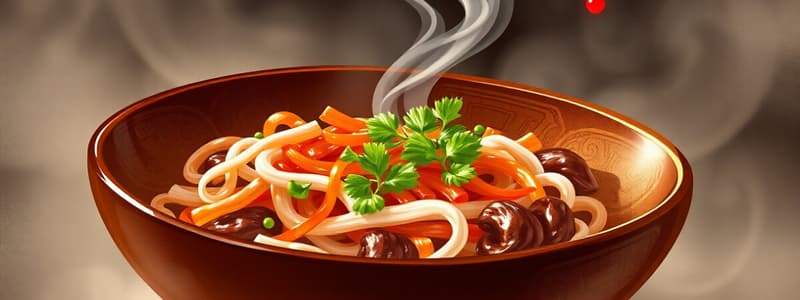Podcast
Questions and Answers
Which of the following best describes the taste profile of umami?
Which of the following best describes the taste profile of umami?
- A purely spicy sensation.
- A mix of salty and bitter.
- A savory or "meaty" flavor. (correct)
- A combination of sweet and sour.
Which component is responsible for umami taste?
Which component is responsible for umami taste?
- Glucose
- Glutamate (correct)
- Lactose
- Fructose
Which cooking technique in Chinese cuisine involves quickly cooking ingredients in a small amount of oil over high heat?
Which cooking technique in Chinese cuisine involves quickly cooking ingredients in a small amount of oil over high heat?
- Slow-Braising (Hŭn)
- Stir-Frying (Chǎo) (correct)
- Roasting
- Steaming (Zhēng)
Which of the following is a key characteristic of the slow-braising (Hŭn) cooking technique in Chinese cuisine?
Which of the following is a key characteristic of the slow-braising (Hŭn) cooking technique in Chinese cuisine?
In Japanese cuisine, what is the foundational broth made from kombu and bonito flakes?
In Japanese cuisine, what is the foundational broth made from kombu and bonito flakes?
Which of the following best describes the role of grilling (Yaki) in enhancing umami in Japanese cuisine?
Which of the following best describes the role of grilling (Yaki) in enhancing umami in Japanese cuisine?
What is the primary purpose of simmering (Nimono) in Japanese cooking, regarding umami?
What is the primary purpose of simmering (Nimono) in Japanese cooking, regarding umami?
Which of the following best characterizes authentic Chinese cuisine?
Which of the following best characterizes authentic Chinese cuisine?
Cantonese cuisine is best known for which of the following flavor profiles and dishes?
Cantonese cuisine is best known for which of the following flavor profiles and dishes?
Which flavor profile is a key characteristic of Sichuan-style Chinese cuisine?
Which flavor profile is a key characteristic of Sichuan-style Chinese cuisine?
What distinguishes Hunan cuisine from other spicy styles of Chinese food?
What distinguishes Hunan cuisine from other spicy styles of Chinese food?
Which type of Chinese cuisine is characterized by sweeter and richer flavors and known for soup dumplings?
Which type of Chinese cuisine is characterized by sweeter and richer flavors and known for soup dumplings?
What is a fundamental focus of authentic Japanese cuisine?
What is a fundamental focus of authentic Japanese cuisine?
Which of the following is a traditional Japanese dish featuring fresh, raw fish served with rice or thinly sliced?
Which of the following is a traditional Japanese dish featuring fresh, raw fish served with rice or thinly sliced?
Which of the following best describes the Japanese dish called 'Ramen'?
Which of the following best describes the Japanese dish called 'Ramen'?
Yakitori, a popular Japanese dish, primarily features what ingredient prepared in what manner?
Yakitori, a popular Japanese dish, primarily features what ingredient prepared in what manner?
What are Donburi in Japanese cuisine?
What are Donburi in Japanese cuisine?
What are Takoyaki?
What are Takoyaki?
What does the use of chopsticks symbolize in Chinese culture?
What does the use of chopsticks symbolize in Chinese culture?
Which of the following sauces is a staple in Japanese cuisine?
Which of the following sauces is a staple in Japanese cuisine?
Flashcards
Umami
Umami
One of the five basic tastes, alongside sweet, salty, sour, and bitter; often described as savory or "meaty".
Stir-Frying (Chǎo, 炒)
Stir-Frying (Chǎo, 炒)
Cooking ingredients quickly in a wok over high heat with a small amount of oil to preserve natural flavors and umami.
Steaming (Zhēng, 蒸)
Steaming (Zhēng, 蒸)
Cooking ingredients with steam in a steamer, preserving their natural flavors and moisture.
Slow-Braising (Hŭn, 燉)
Slow-Braising (Hŭn, 燉)
Signup and view all the flashcards
Making Dashi (出汁)
Making Dashi (出汁)
Signup and view all the flashcards
Grilling (Yaki, 焼き)
Grilling (Yaki, 焼き)
Signup and view all the flashcards
Simmering (Nimono, 煮物)
Simmering (Nimono, 煮物)
Signup and view all the flashcards
Chinese Cuisine
Chinese Cuisine
Signup and view all the flashcards
Cantonese Style Cuisine (粵菜)
Cantonese Style Cuisine (粵菜)
Signup and view all the flashcards
Sichuan Style Cuisine (川菜)
Sichuan Style Cuisine (川菜)
Signup and view all the flashcards
Hunan Style Cuisine (湘菜)
Hunan Style Cuisine (湘菜)
Signup and view all the flashcards
Shanghainese Style Cuisine (沪菜)
Shanghainese Style Cuisine (沪菜)
Signup and view all the flashcards
Japanese Cuisine
Japanese Cuisine
Signup and view all the flashcards
Sushi & Sashimi
Sushi & Sashimi
Signup and view all the flashcards
Ramen
Ramen
Signup and view all the flashcards
Tempura
Tempura
Signup and view all the flashcards
Kimono and Yukata
Kimono and Yukata
Signup and view all the flashcards
Chinese Wedding Traditions
Chinese Wedding Traditions
Signup and view all the flashcards
Chinese New Year Traditions
Chinese New Year Traditions
Signup and view all the flashcards
Examples of essential chinese sauces
Examples of essential chinese sauces
Signup and view all the flashcards
Study Notes
- Asian cuisine is presented by Group II, with members Asi, Delfin John; Schofield, Mark Angelo; Fundales, John Vincent; and Rivamonte, Jullie Ann.
Traditional Cooking Techniques & Use of Umami
- Umami is one of the five basic tastes: sweet, salty, sour, and bitter.
- Umami is described as a savory or "meaty" flavor.
- Umami is associated with glutamate-rich foods like aged cheeses, soy sauce, mushrooms, and meats.
- Glutamate is an amino acid that enhances flavor and contributes depth to savory dishes.
- Umami was identified as a distinct taste by Japanese scientist Kikunae Ikeda in the early 20th century.
Common Cooking Techniques in Chinese Cuisine Highlighting Umami
- Stir-Frying (Chǎo, 炒): Ingredients are cooked quickly in a small amount of oil over high heat in a wok.
- Stir-frying preserves the natural flavors and umami of vegetables, meats, and mushrooms.
- Steaming (Zhēng, 蒸): Ingredients like fish, dumplings, or buns are placed in a steamer and cooked with steam.
- Steaming preserves natural flavors and moisture.
- Slow-Braising (Hŭn, 蔔): Foods are cooked slowly in liquid (broth, soy sauce, wine) at low heat over an extended period.
- Slow-braising breaks down tougher meat cuts and melds flavors together.
Umami in Japanese Cuisine
- Umami is a key component of many traditional Japanese cooking techniques.
- Japanese cooking techniques are designed to extract, balance, and emphasize savory flavors.
Techniques in Japanese Cuisine
-
Dashi is the foundation of many Japanese dishes and is made by boiling kombu (seaweed) and bonito flakes (dried fish) to create a flavorful broth.
Dashi is the essential base for soups (like miso soup), sauces, and hot pots.
-
Grilling (Yaki, 焼き): Ingredients like fish (mackerel, salmon), meats, and vegetables are grilled over an open flame or on a grill..
-
Simmering (Nimono, 煮物): Ingredients are gently simmered in a liquid, often a stock or broth including soy sauce, mirin, sake, and dashi.
Authentic Chinese Cuisine
- Chinese cuisine is a diverse and rich culinary tradition characterized by regional flavors,
- Cantonese Style (粵菜): Features mild, fresh flavors, dim sum, and roasted meats like char siu and roast duck.
- Sichuan Style (川菜): Features spicy, bold, and numbing flavors, with Sichuan peppercorns in dishes like mapo tofu and kung pao chicken.
- Hunan Style (湘菜): Features spicy flavors without the numbing effect, often using steaming or braising.
- Shanghainese Style (沪菜): Characterized by sweeter and richer flavors, especially known for soup dumplings (xiaolongbao).
Authentic Japanese Cuisine
- Japanese cuisine focuses on fresh, high-quality ingredients, minimal seasoning, and umami flavors.
- Popular dishes include Sushi & Sashimi: Fresh raw fish with rice or thinly sliced fish.
- Ramen: Wheat noodles in rich broth (tonkotsu, shoyu, miso ramen).
- Tempura: Lightly battered and deep-fried seafood or vegetables.
- Yakitori: Grilled skewered chicken cooked over charcoal.
- Donburi: Rice bowl dishes with various toppings like gyudon (beef), katsudon (pork cutlet), and oyakodon (chicken and egg).
- Takoyaki: Crispy, round, batter-fried balls with chopped octopus (tako), tempura bits, and green onions.
Traditional Culture of Japanese
- Japanese Tea Ceremony is a traditional ritual.
- Noh and Kabuki are traditional Japanese drama forms.
- Kimono and Yukata, traditional Japanese garments, part of Japanese culture.
Traditional Culture of Chinese
- Chinese Weddings: Reflect thousands of years of customs rooted in Confucian values,
- Chinese New Year: Celebrates togetherness.
- Chopsticks: Symbolize kindness and gentleness.
Essential Spices and Sauces: Chinese Spices
- Include Sichuan Peppercorns, Star Anise, Chinese Five-Spice Powder, and White Pepper.
- Include Dried Chili Peppers, Ginger, Garlic, and Scallions.
Essential Spices and Sauces: Chinese Sauces
- Include Soy Sauce (Light & Dark), Oyster Sauce, Hoisin Sauce, and Black Bean Sauce.
- Include Chili Oil, Shaoxing Wine, and Vinegar (Chinkiang Black Vinegar).
Essential Spices and Sauces: Japanese Spices
- Wasabi, Shichimi Togarashi, and Sansho Pepper.
- Ginger, Garlic, and Sesame Seeds.
Essential Spices and Sauces: Japanese Sauces
- Soy Sauce (Shoyu), Miso Paste, and Mirin.
- Rice Vinegar, Ponzu Sauce, Teriyaki Sauce, Tonkatsu Sauce, and Dashi.
Studying That Suits You
Use AI to generate personalized quizzes and flashcards to suit your learning preferences.




